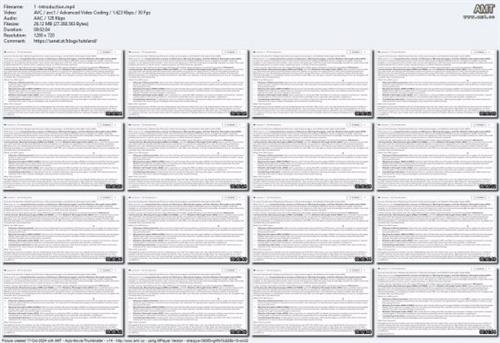- Thread Starter
- #1
Learn Profitable Strategies in Capital Markets

FIBONACCI MOVING AVERAGE (MA) SIMPLE MOVING AVERAGE (SMA) EXPONENTIAL MOVING AVERAGE (EMA) RELATIVE STRENGTH INDEX
What you'll learn
MASTER SIMPLE MOVING AVERAGE
MASTER MOVING AVERAGE
MASTER FIBONACCI
MASTERING EXPONENTIAL MOVING AVERAGE (EMA)
MASTERING RELATIVE STRENGTH INDEX (RSI)
Requirements
NO PREREQUISITES
Description
Detailed Course Description: Fibonacci, Moving Averages, and Relative Strength Index (RSI)This detailed course will provide a comprehensive understanding of Fibonacci retracement, Moving Averages (MA), Simple Moving Averages (SMA), Exponential Moving Averages (EMA), and the Relative Strength Index (RSI). The course is designed for traders, financial analysts, and individuals seeking to apply technical analysis in stock, forex, cryptocurrency, or other financial markets. Each topic is broken down into theory and practical applications with examples to help you master these essential technical indicators.Module 1: Fibonacci Retracement - Understanding Market CorrectionsFibonacci retracement is a key technical analysis tool that identifies potential reversal points by measuring the retracement of an asset's price. In this module, you will learn:Introduction to Fibonacci Sequence: Origin and relevance to financial markets, along with the mathematical concept of Fibonacci numbers.Key Fibonacci Levels: Understanding how the 23.6%, 38.2%, 50%, 61.8%, and 78.6% retracement levels are calculated and used in technical analysis.Fibonacci Retracement in Practice: How to draw Fibonacci retracement lines and apply them to identify potential support and resistance levels in bullish or bearish markets.Combining Fibonacci with Other Indicators: Learn how to integrate Fibonacci retracements with other technical indicators for better decision-making.Module 2: Moving Averages (MA) - Smoothing Price Action to Identify TrendsMoving Averages are one of the most widely used technical indicators that help in identifying the direction and strength of trends by smoothing out price data. This module covers:Types of Moving Averages: Understanding the difference between Simple, Exponential, and Weighted Moving Averages.How Moving Averages Work: Analyzing how MA smooths out price fluctuations to identify trends.Applications of Moving Averages: Spotting trend direction, identifying dynamic support and resistance, and signaling entry/exit points through crossover strategies (e.g., when a short-term MA crosses a long-term MA).Module 3: Simple Moving Average (SMA) - The Traditional Trend IndicatorThe Simple Moving Average is the most basic form of moving average, giving equal weight to all data points in the calculation. In this module, you will learn:Calculating SMA: How to calculate the SMA over specific time periods (e.g., 50-day or 200-day).Interpreting SMAs in Market Analysis: How the SMA can act as a support or resistance level and help you spot the general market trend (uptrend or downtrend).Common SMA Strategies: Learn common strategies such as SMA crossovers, golden crosses, and death crosses, which are frequently used for trading signals.Module 4: Exponential Moving Average (EMA) - Reacting Faster to Market MovementsThe Exponential Moving Average gives more weight to recent price data, making it more responsive to recent price movements. This module will cover:EMA Calculation: Understanding how EMA differs from SMA by assigning a higher weight to recent prices, resulting in a more adaptive indicator.Using EMA in Volatile Markets: Learn why EMA is preferred for short-term trading or in volatile markets, as it reacts faster to price changes.Module 5: Relative Strength Index (RSI) - Gauging Market MomentumThe RSI is a momentum oscillator that measures the speed and change of price movements, helping traders identify overbought and oversold conditions in an asset. This module explains:RSI Formula: How RSI is calculated using price gains and losses over a specific period, typically 14 days.Interpreting RSI Values: Understanding the key thresholds (30 and 70) to identify overbought (above 70) and oversold (below 30) conditions.Divergences and Failure Swings: How to spot RSI divergences (when price moves in one direction and RSI moves in the opposite), which can signal potential reversals.Combining RSI with Other Indicators: Explore how RSI is often used with Moving Averages, Bollinger Bands, and support/resistance levels to enhance trading signals and refine strategy execution.Course Learning ObjectivesMaster Fibonacci Retracement: Gain the skills to use Fibonacci retracement levels effectively to predict potential turning points in the market.Understand Moving Averages: Learn how to apply different types of moving averages (SMA and EMA) to smooth out price data and analyze trends.Analyze Market Trends: Utilize moving averages and crossovers to spot trend reversals and trading opportunities.Leverage RSI: Understand how to use RSI to assess momentum and determine overbought or oversold conditions in any market.Build Strategies: Combine these indicators to create robust trading strategies for different market conditions.Target Audience:Beginner to Expert traders and investors interested in improving their technical analysis skills.Financial analysts seeking to enhance their understanding of key market indicators.Traders in stock, forex, cryptocurrency, or commodities markets.Individuals looking to use technical analysis tools for more informed and strategic investment decisions.Course Outcomes: By the end of this course, participants will be proficient in using Fibonacci retracement levels, moving averages, and RSI to analyze market trends and make informed trading decisions. These essential skills will equip students to develop their own trading strategies and improve their market timing, enabling them to achieve better returns on their investments.
Who this course is for
STUDENTS - PROFESSIONALS - BEGINNERS TO EXPERIENCED
Homepage:

Say "Thank You"
rapidgator.net:
ddownload.com:

Published 10/2024
MP4 | Video: h264, 1280x720 | Audio: AAC, 44.1 KHz, 2 Ch
Language: English | Duration: 2h 0m | Size: 1.44 GB
MP4 | Video: h264, 1280x720 | Audio: AAC, 44.1 KHz, 2 Ch
Language: English | Duration: 2h 0m | Size: 1.44 GB
FIBONACCI MOVING AVERAGE (MA) SIMPLE MOVING AVERAGE (SMA) EXPONENTIAL MOVING AVERAGE (EMA) RELATIVE STRENGTH INDEX
What you'll learn
MASTER SIMPLE MOVING AVERAGE
MASTER MOVING AVERAGE
MASTER FIBONACCI
MASTERING EXPONENTIAL MOVING AVERAGE (EMA)
MASTERING RELATIVE STRENGTH INDEX (RSI)
Requirements
NO PREREQUISITES
Description
Detailed Course Description: Fibonacci, Moving Averages, and Relative Strength Index (RSI)This detailed course will provide a comprehensive understanding of Fibonacci retracement, Moving Averages (MA), Simple Moving Averages (SMA), Exponential Moving Averages (EMA), and the Relative Strength Index (RSI). The course is designed for traders, financial analysts, and individuals seeking to apply technical analysis in stock, forex, cryptocurrency, or other financial markets. Each topic is broken down into theory and practical applications with examples to help you master these essential technical indicators.Module 1: Fibonacci Retracement - Understanding Market CorrectionsFibonacci retracement is a key technical analysis tool that identifies potential reversal points by measuring the retracement of an asset's price. In this module, you will learn:Introduction to Fibonacci Sequence: Origin and relevance to financial markets, along with the mathematical concept of Fibonacci numbers.Key Fibonacci Levels: Understanding how the 23.6%, 38.2%, 50%, 61.8%, and 78.6% retracement levels are calculated and used in technical analysis.Fibonacci Retracement in Practice: How to draw Fibonacci retracement lines and apply them to identify potential support and resistance levels in bullish or bearish markets.Combining Fibonacci with Other Indicators: Learn how to integrate Fibonacci retracements with other technical indicators for better decision-making.Module 2: Moving Averages (MA) - Smoothing Price Action to Identify TrendsMoving Averages are one of the most widely used technical indicators that help in identifying the direction and strength of trends by smoothing out price data. This module covers:Types of Moving Averages: Understanding the difference between Simple, Exponential, and Weighted Moving Averages.How Moving Averages Work: Analyzing how MA smooths out price fluctuations to identify trends.Applications of Moving Averages: Spotting trend direction, identifying dynamic support and resistance, and signaling entry/exit points through crossover strategies (e.g., when a short-term MA crosses a long-term MA).Module 3: Simple Moving Average (SMA) - The Traditional Trend IndicatorThe Simple Moving Average is the most basic form of moving average, giving equal weight to all data points in the calculation. In this module, you will learn:Calculating SMA: How to calculate the SMA over specific time periods (e.g., 50-day or 200-day).Interpreting SMAs in Market Analysis: How the SMA can act as a support or resistance level and help you spot the general market trend (uptrend or downtrend).Common SMA Strategies: Learn common strategies such as SMA crossovers, golden crosses, and death crosses, which are frequently used for trading signals.Module 4: Exponential Moving Average (EMA) - Reacting Faster to Market MovementsThe Exponential Moving Average gives more weight to recent price data, making it more responsive to recent price movements. This module will cover:EMA Calculation: Understanding how EMA differs from SMA by assigning a higher weight to recent prices, resulting in a more adaptive indicator.Using EMA in Volatile Markets: Learn why EMA is preferred for short-term trading or in volatile markets, as it reacts faster to price changes.Module 5: Relative Strength Index (RSI) - Gauging Market MomentumThe RSI is a momentum oscillator that measures the speed and change of price movements, helping traders identify overbought and oversold conditions in an asset. This module explains:RSI Formula: How RSI is calculated using price gains and losses over a specific period, typically 14 days.Interpreting RSI Values: Understanding the key thresholds (30 and 70) to identify overbought (above 70) and oversold (below 30) conditions.Divergences and Failure Swings: How to spot RSI divergences (when price moves in one direction and RSI moves in the opposite), which can signal potential reversals.Combining RSI with Other Indicators: Explore how RSI is often used with Moving Averages, Bollinger Bands, and support/resistance levels to enhance trading signals and refine strategy execution.Course Learning ObjectivesMaster Fibonacci Retracement: Gain the skills to use Fibonacci retracement levels effectively to predict potential turning points in the market.Understand Moving Averages: Learn how to apply different types of moving averages (SMA and EMA) to smooth out price data and analyze trends.Analyze Market Trends: Utilize moving averages and crossovers to spot trend reversals and trading opportunities.Leverage RSI: Understand how to use RSI to assess momentum and determine overbought or oversold conditions in any market.Build Strategies: Combine these indicators to create robust trading strategies for different market conditions.Target Audience:Beginner to Expert traders and investors interested in improving their technical analysis skills.Financial analysts seeking to enhance their understanding of key market indicators.Traders in stock, forex, cryptocurrency, or commodities markets.Individuals looking to use technical analysis tools for more informed and strategic investment decisions.Course Outcomes: By the end of this course, participants will be proficient in using Fibonacci retracement levels, moving averages, and RSI to analyze market trends and make informed trading decisions. These essential skills will equip students to develop their own trading strategies and improve their market timing, enabling them to achieve better returns on their investments.
Who this course is for
STUDENTS - PROFESSIONALS - BEGINNERS TO EXPERIENCED
Homepage:
Screenshots

Say "Thank You"
rapidgator.net:
You must reply in thread to view hidden text.
ddownload.com:
You must reply in thread to view hidden text.
